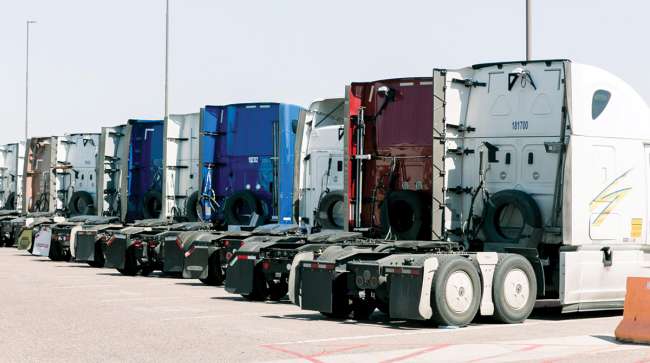Senior Reporter
March’s Average Used Class 8 Retail Price Breaks $100,000

[Stay on top of transportation news: Get TTNews in your inbox.]
The average retail price in March of a used Class 8 vehicle pushed past the $100,000 mark for the first time, ACT Research reported.
“It was $101,736,” ACT Vice President Steve Tam told Transport Topics. “A year earlier it was $53,412. Not quite double, but darn near.”
The previous record was set in February at $94,321.
Total sales climbed, too.
ACT estimated used Class 8 sales in March numbered 25,200 compared with 23,800 a year earlier. In February, sales were 21,900.

Tam
“We are getting a lot of phone calls from folks wanting to know if this is going to keep going,” Tam said.
“We are seeing freight growth get a little less robust than what it’s been over this crazy cycle,” Tam said. And while opinions vary on what the new economic details imply, this new questioning element “is something to undermine people’s prior thoughts and actions.”
Tam said the wholesale markets, or dealers buying from and selling to other dealers, are starting to pick up; and inventory turns are slowing down so it is taking a little bit longer to move the equipment the dealers do have.
The market for the much older, higher mileage trucks is continuing to reset lower, something Tam mentioned in ACT’s February report. “So this is a continuation and a confirmation.”
Eventually that trend will work its way up the ‘food chain’ to newer model, lower mileage equipment, he said. “But we are months away from something like that happening.”
The average price for 3-year-old trucks climbed to $151,811 compared with $96,759 a year earlier. “I don’t think there is much room left to run [in this segment].” March’s price was essentially flat with February’s average price of $151,850.
The average mileage on a Class 8 sold in March was 429,000 compared with 422,000 a year ago, according to ACT. The average age remained the same as a year earlier, at 6 years, 4 months.
Each month, ACT surveys a sample of dealers, wholesalers and auctioneers as well as a few large fleets to determine average price, age and mileage, and estimated industry volumes.

Visser
Chris Visser, commercial truck senior analyst at J.D. Power Valuation Services, wrote in a recent report: “For more than a year, we’ve been discussing the various factors keeping the freight market superheated and predicting what could cause eventual cooling. Based on published freight volume and pricing data, it is apparent the freight environment is undergoing some degree of maturation.”
Still, while used truck sales per dealer rooftop are 20% to 25% below what he would expect in a typical economy, Visser wrote this lower percentage is due solely to an inadequate supply of trucks to sell, not lack of demand.
David Jackson, CEO of Knight-Swift Transportation Holdings Inc., said during the company’s latest earning call the operational pressures are mounting, especially for small carriers and recent entrants.
“The cost of everything is on the rise, especially for those that don’t have economies of scale, speaking particularly to small carriers that we might compete with,” Jackson said. “Cost per mile has been irreversibly increased in many ways, in many areas.”

Transport Topics' Seth Clevenger and Marissa Gamache take you through the process of determining North America’s largest 3PLs in the expanded Transport Topics Top 100 Logistics Companies list. Tune in above or by going to RoadSigns.TTNews.com.
Jackson noted his fleet is not selling its used trucks at the normal pace that it is accustomed to because it can’t replace them with all the new trucks it needs — truck makers continue to face persistent supply chain woes that have crimped production for many months.
“And the limited number of used trucks we are selling, in some cases, we’re selling these for as much or close to what we paid for them brand new before we put 450,000 or 500,000 miles on the trucks,” he said. “And so that sets up a whole new problem if the economy is headed for a little soft patch, and the banks decide to not be so aggressive in the financing. I would say that watching what’s happening with equipment is maybe the most valuable thing we can look at for the crystal ball for full truckload.”
Meanwhile, J.B. Hunt Transport Services reported about $18 million of gains on sale of equipment in the first quarter, “which are atypical for us,” Chief Financial Officer John Kuhlow said during the company’s earnings call. “We had very few trades last year as we hold most of our equipment to support our organic growth.” He did not offer more commentary.
J.B. Hunt also reported its truckload segment ended the first quarter with 709 company-owned tractors compared with 798 a year earlier. Independent contractors provided 1,527 tractors compared with 918 a year earlier.
Want more news? Listen to today's daily briefing below or go here for more info:



